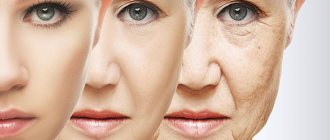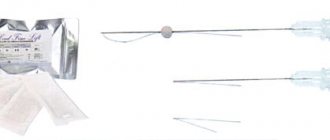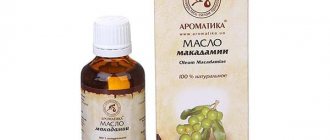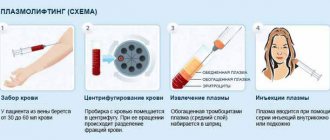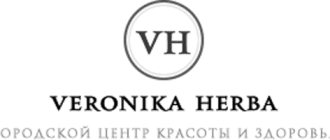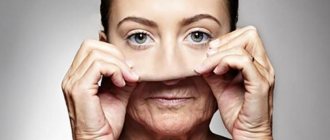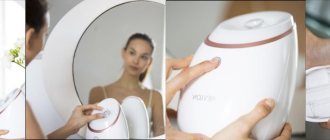The essence of plasma lifting
The effect of plasma isolated from the patient’s blood before the procedure on skin cells is the basis of the plasma lifting technique. Plasma is injected into a selected area of skin using microneedles or a syringe with replaceable needles. This technology is used not only for skin aging and the appearance of wrinkles, but also for baldness and weak hair - plasma injections can also be given into the scalp.
Plasmolifting has several serious advantages over other injection rejuvenation techniques. The main one is relative safety. Plasma for injection is always compatible with the patient's body because it is obtained from his own blood.
Contraindications
Despite its safety and effectiveness, plasma lifting is not suitable for everyone. In case of diseases of the circulatory system, exacerbation of autoimmune diseases, pregnancy, breastfeeding, it is better to postpone plasma injections until later or choose another rejuvenating procedure.
The essence of biorevitalization
Another injection procedure that helps restore youth to the face is biorevitalization. Hyaluronic acid is the main component of biorevitalization preparations; thanks to it, the skin becomes more hydrated and elastic, and recovers faster.
A little about hyaluronic acid
Hyaluronic acid keeps the skin hydrated because it retains moisture in its cells and creates an imperceptible protective film on the surface. Hyaluronic acid in the human body is found not only in the skin, but also in all other parts of it - in joints, bones, and nerve tissues. For the first time it was discovered in the eye, or rather in its vitreous body.
As a person ages, hyaluronic acid is removed from the body more actively, which leads to the appearance of wrinkles and sagging skin. 25 years is still a very young age, but by this time the formation of the element in the body slows down.
Contraindications
During a biorevitalization session, not pure hyaluronic acid is injected into the skin, but a drug based on it. Some components of this drug may cause an allergic reaction. Despite the fact that the likelihood of such an outcome is low, performing biorevitalization on people allergic to the components of hyauronate is unacceptable. Those who suffer from cancer and autoimmune diseases, pregnant and lactating women will also have to refuse biorevitalization. If there is damage to the facial skin, the procedure is also not performed.
How does mesotherapy differ from facial biorevitalization and what is more effective?
To consider what the difference is between these procedures and what to choose in a particular case, we offer a comparison table.
| Existing problem | Mesotherapy | Biorevitalization |
| Uneven, unnatural complexion | Gives a pronounced positive effect | Gives a pronounced positive effect |
| Post-acne, acne, enlarged pores | Excellent results with a well-composed cocktail of drugs | Small positive effect |
| Dry and dehydrated skin | Moderate effect | Excellent result |
| Cuperosis | Good results due to the presence of ingredients in the preparation that strengthen the walls of blood vessels | Not applicable for elimination |
| Photoaging | When using cocktails with antioxidants, it gives a positive effect after 30 years | Very effective, regardless of age, triggers natural defense mechanisms against UV |
| Folds of fat on the cheeks, chin, cheekbones | Effective for eliminating small deposits during the administration of lipolytics | Not applicable for elimination |
| Jowls, sagging skin, drooping eyelids, wrinkles - deep and medium | Has no effect | Has no effect |
Comparison by main characteristics of procedures
| Characteristic | Mesotherapy | Biorevitalization |
| Mechanism of action | Varies depending on the drugs used | Deep hydration, filling small wrinkles |
| Drugs | Vitamins, minerals, lifting compounds, homeopathic remedies, hyaluronic acid in liquid form (not always included in cocktails) | Hyaluronic acid in the form of a gel, enriching additives - amino acids, vitamins, etc. |
| Hyaluronic acid concentration | 0,5-1% | From 1.5% |
| Type of hyaluronic acid | Unstabilized | Unstabilized |
| Processing areas | Body, face, scalp | Neckline, back of hands, face |
| Number of procedures in the course and interval between them | 4-8, 1 week | 3-5, 3 weeks |
| Effect duration | 6-18 months | 6 months |
| Manifestation of the effect | After completing the course | After the first procedure |
Differences by age
| Age | Mesotherapy | Biorevitalization |
| Up to 30 years old | It is optimal, since the body produces a sufficient amount of hyaluronic acid, but there are problems characteristic of young skin - uneven texture, acne, dark circles under the eyes, acne, uneven tone | Not applicable because there is no need |
| After 30 years | Does not eliminate signs of aging | Ideal as it protects against skin thinning, drying out, and prevents aging. |
Which technique is better?
Both rejuvenation technologies are quite safe and effective; it is not easy to choose the most suitable one. Let's compare plasma lifting and biorevitalization according to eight main criteria.
Simplicity
Both plasma lifting and biorevitalization involve the introduction of a drug into the skin, so they are not too different from each other in ease of implementation. A small obstacle before rejuvenation with the help of plasma is a blood test for biochemistry. The analysis is necessary to check the condition of the blood and make sure there are no hidden contraindications to plasma lifting. Biorevitalization turns out to be even simpler than plasma therapy, therefore you can influence the skin with hyaluronic acid not only with injections, but also using a laser. The ability to refuse injections will allow people who are afraid of syringes and needles to make an appointment with a cosmetologist for a rejuvenation procedure without any doubt.
Price
The equipment for plasma lifting is more specific, and the procedure itself is more complicated due to the fact that it requires isolating plasma from the blood immediately before the session. For the greatest effect, plasma lifting sessions may require more. For these three reasons, a course of plasma lifting turns out to be more expensive than a course of biorevitalization.
Session duration
The time required for procedures varies slightly. A facial skin plasmolifting session usually takes only 30 minutes, while a cosmetologist performs hyaluronic acid injections for about an hour.
Efficiency
Both biorevitalization and plasmolifting are quite effective procedures, but they differ in how quickly the results appear and how long the youthful appearance of the skin lasts.
Hyaluronic acid injections have an almost immediate effect. On the same day of the procedure, patients notice that their complexion has become more even and their skin has begun to smooth out. You will have to wait about two weeks for the effect of plasma lifting. To ensure a guaranteed result, you not only need to attend injection sessions on time and follow care recommendations, but also eat a balanced diet and drink enough water every day.
Now it may seem that biorevitalization is much more effective than plasma lifting, but the effect of plasma on the skin has an advantage - the youth and elasticity of the skin is preserved for one to two years. Biorevitalization procedures will have to be repeated several times a year to maintain the effect.
Suitable age
Some skin diseases that actively manifest themselves in adolescence can be treated with plasma lifting. Plasma injections, for example, help get rid of acne and scars. After 55 years, plasma therapy is contraindicated, since this procedure strains the immune system. Chronic diseases, which many people have in adulthood, can worsen.
Injections of hyaluronic acid are suitable for patients over 25 years of age, because until this age the body independently produces enough of this substance. Unlike plasmolifting, biorevitalization does not cause health problems if the patient is over fifty years old. Moreover, the intake of hyaluronic acid into the body can improve its well-being.
Disease Control
The most serious obstacle to biorevitalization is psoriasis. In the presence of such a diagnosis, the introduction of hyaluronate into the skin is unacceptable. Plasmolifting is sometimes used specifically to make the symptoms of psoriasis less pronounced - it is not yet possible to completely cure this disease.
Hyaluronic acid protects the skin from inflammation, so it rarely appears on the face after biorevitalization. A plasma lifting session, on the contrary, can cause inflammation in the treated area of skin.
Allergenicity
For the greatest safety, when collecting blood, special tubes coated with gel on the inside are used. This gel prevents blood components from mixing after centrifugation.
Most people do not know the name of each substance they are allergic to, so they do not expect an allergic reaction after injecting a hyaluronic acid product into their skin. Such problems do not arise so often after biorevitalization, but the likelihood of their occurrence is slightly higher than after the plasma lifting procedure.
Skin condition after the procedure
During a plasma lifting or biorevitalization session, the cosmetologist injects the drug with a very thin puncture, so you should not be afraid of temporary redness of the skin immediately after the procedure. If the skin remains red for a long time, this may indicate inflammation or an allergic reaction. In this case, you need to consult a doctor.
The appearance of small swellings in the places where punctures were made is a normal consequence of biorevitalization. The bumps on the skin do not last long; they disappear on average two days after the session. Some patients experience hyperemia, overflow of blood vessels with blood. Symptoms of hyperemia - redness, swelling. Possible increase in temperature. All these unpleasant phenomena soon disappear.
Which sequence of procedures is still correct?
Botox and biorevitalization – what follows what?
The main unwritten rule of cosmetologists sounds like this: first – aggressive procedures, then – gentle ones. At the same time, the skin must receive complete rest between such sessions.
Botox is an aggressive drug; hyaluronic acid is considered softer and more gentle. Therefore, ideally, of course, it is first necessary to carry out biorevitalization, and then, after some time, Botox.
In some cases, the sequence of biorevitalization and Botox can be changed. At the same time, the requirements for the administration of botulinum toxin after hyaluron are not so stringent. It is necessary to wait 14-28 days after the biorevitalization procedure and you can contact a specialist for the next course of anti-aging injections.
It is important to remember that after Dysport, biorevitalization can only be done with the approval of a cosmetologist. To do this, the client must provide the specialist with information about the drug used for biorevitalization (if the procedures are carried out by different specialists)
The ideal option would be to provide official papers describing the product. If a woman does not have information about biorevitalizant, she should avoid administering botulinum toxin for a while. It’s not worth the risk, because it’s impossible to predict how two drugs will behave. Such mixing can lead to disastrous consequences.
Simultaneous exposure
It is unacceptable to conduct plasma lifting and biorevitalization sessions one after another. A competent combination of these techniques gives a high-quality result, because the two substances improve the absorption of each other in the body.
The combination of rejuvenation technologies occurs in two stages. First, three to four plasma lifting procedures are performed at intervals of a week, the course takes about a month. Another week is spent on skin restoration, after which the patient attends a contouring session using hyaluronic acid.
Skin care courses can be supplemented with mesotherapy procedures. This technology is also based on injections, but it is not natural components that are injected into the skin, but chemical cocktails. In some cases, mesotherapy causes allergic reactions, so consult your doctor before you begin such treatments.
Skin care
Whatever rejuvenation technique is chosen, it is necessary to follow the rules for skin care after the procedure.
Rubbing your face with a chlorhexidine solution or another disinfectant recommended by a cosmetologist will help prevent infection. On the contrary, visiting swimming pools, saunas, baths is not recommended, because the risk of harmful bacteria getting into wounds in such establishments increases. Tanning in a solarium or sunbathing after a rejuvenation session can cause age spots to appear, so use sunscreen before going outside on a sunny day.
Sometimes after biorevitalization, noticeable marks from punctures appear on the face, they are called petechiae. They usually disappear quickly, but if petechiae remain on the skin for too long, it is necessary to apply a special product to the skin every few hours. A specialist will tell you whether it is necessary.
Duration of the cosmetology course
The number of procedures required to solve the problem is selected individually. Usually, five to six procedures are enough for this, and the duration is no more than two months.
The choice between mesotherapy and plasma lifting
Having familiarized yourself with the features of both cosmetological methods, you can draw a conclusion about their benefits in solving a specific problem. It would also be a good idea to consult with a specialist. If we make a direct comparison of “mesotherapy or plasma lifting”, then when solving specific problems it is noted that mesotherapy allows you to get a positive result faster, while the positive effect of plasma lifting remains for a longer time.
Some experts also note that plasma lifting is a more natural way of rejuvenation, since it uses “native” blood plasma, while mesotherapy offers a wide range of biologically active drugs.
